May 27, 2022
Air Date: May 27, 2022
FULL SHOW
SEGMENTS

Toxic Pet Collars
View the page for this story
In the past decade, the EPA has received over 98,000 reports of harm and over 2500 reports of pet deaths connected to one brand of pesticide-containing flea collars, Seresto. But the EPA has never issued any warnings or recalls of Seresto collars. Nathan Donley is the Environmental Health Science Director at the Center for Biological Diversity, which sued EPA over Seresto collars, and he joins Host Bobby Bascomb to discuss. (11:01)

Beyond the Headlines
/ Peter DykstraView the page for this story
This week, Environmental Health News Editor Peter Dykstra and Host Aynsley O'Neill discuss Australia’s election of a more climate-forward Parliament and the ousting of its former climate denying Prime Minister. They then move on to Secretary of Interior Deb Haaland's task force to replace derogatory place names on federal public lands. For history they flip the pages back to 1905 when the Salton Sea, the largest lake in California, was created after a major engineering mistake. (05:22)
“Trust”: Great Blue Heron
/ Mark Seth LenderView the page for this story
The long-legged, broad-winged Great Blue Heron gathers in colonies to breed. Living on Earth's Explorer-in-Residence Mark Seth Lender shares his observations of one mating pair sharing the duties of parenting at a rookery inland of the Connecticut River. (02:24)
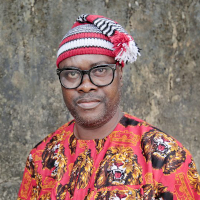
Justice for Oil Spill Victims in Nigeria
View the page for this story
The 2022 Goldman Environmental Prize Recipient for Africa is Chima Williams, an environmental lawyer who worked with two communities to hold Royal Dutch Shell accountable for disastrous oil spills in Nigeria. Co-hosts Aynsley O’Neill and Bobby Bascomb talk about the devastation the spills caused and how Chima Williams and his colleagues brought the case to the Hague in the Netherlands to pursue justice. (08:05)

Albatross Divorce Amid Warming Waters
/ Don LymanView the page for this story
Albatrosses typically mate for life, but new evidence shows warming waters may cause an increase in albatross couple separation. Living on Earth's Don Lyman has the report. (02:51)
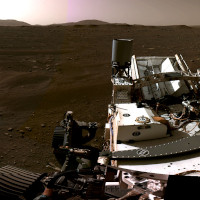
The Sounds of Mars
View the page for this story
The first successful Mars lander was Viking 1 in 1976, and now, after dozens of missions NASA has finally captured the first ever audio recorded on the surface of the red planet. Host Aynsley O'Neill shares these recordings with Host Bobby Bascomb and explains how Mars' atmosphere alters sound compared to how we experience it here on Earth. (04:17)
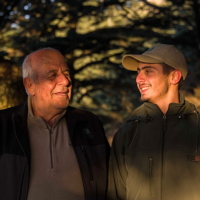
Safeguarding the Cedars of Lebanon
View the page for this story
The Al-Shouf Biosphere Reserve is home to Lebanon’s iconic cedar forest, and even as the country faces a severe economic crisis locals are working to restore the land and practice sustainable agriculture to make a living. Elizabeth Fitt is a freelance photojournalist based in Beirut who wrote about the Shouf Reserve for Mongabay and joins Host Bobby Bascomb. (12:38)
Show Credits and Funders
Show Transcript
HOSTS: Bobby Bascomb, Aynsley O’Neill
GUESTS: Nathan Donley, Elizabeth Fitt, Chima Williams
REPORTERS: Peter Dykstra, Mark Seth Lender, Don Lyman
[THEME]
BASCOMB: From PRX – this is Living On Earth.
[THEME]
BASCOMB: I’m Bobby Bascomb.
O’NEILL: And I’m Aynsley O’Neill
EPA is under fire for not taking action against certain flea collars despite concerns from pet owners.
DONLEY: We’ve got 100,000 people who have called the authorities about just this one product alone and nothing has been done for the last 10 years. I mean if that doesn’t spur action, then what will? EPA still hasn’t answered our question of how many dead pets is too many.
BASCOMB: Also, surviving Lebanon’s economic crisis with sustainability.
FITT: Their ecologically friendly projects are staffed by people from the local area and they get paid for the work that they do. There you can see an immediate positive for people in the area, especially in a country that's suffering economic crisis.
BASCOMB: That and more this week on Living on Earth – Stick Around!
[NEWSBREAK MUSIC: Boards Of Canada “Zoetrope” from “In A Beautiful Place Out In The Country” (Warp Records 2000)]
Toxic Pet Collars

Flea and tick-borne diseases can be very dangerous for pets. However, some approaches to protecting pets, like the Seresto flea collar, have faced scrutiny for their potential safety hazards. (Photo: dave.see, Flickr, CC BY 2.0)
[THEME]
O’NEILL: From PRX and the Jennifer and Ted Stanley Studios at the University of Massachusetts Boston, this is Living on Earth. I’m Aynsley O’Neill.
BASCOMB: And I’m Bobby Bascomb.
Here in flea and tick season, many pet owners may be reaching for collars treated with pesticides or topical gels–to protect their furry friends. Some pet collars contain pesticides that are neurotoxins designed to kill insects, but they can also harm mammals including the dogs who wear them. In the past decade, the EPA has received over 98,000 reports of harm and over 2,500 reports of pet deaths connected with one brand of flea collars, Seresto. But the EPA has never issued any warnings or recalls about Seresto collars. Under pressure from the Center for Biological Diversity, the EPA has enlisted the help of the FDA to analyze the incident report data. And the Inspector General for the EPA is investigating the possibility that EPA violated federal law by failing to take action against Seresto flea collars given the concern. For more, I’m joined now by Nathan Donley, the Environmental Health Science Director at the Center for Biological Diversity, that sued the EPA over these collars and first brought the issue to light. Nathan, welcome to Living on Earth!
DONLEY: Yeah, thanks for having me.
BASCOMB: How are these collars still allowed on the market? I mean, what's happening here?
DONLEY: Well, I think one reason is EPA has no triggers in place for when reports of poisoning require corrective action. And this is the case both for pets and for humans. I mean, if you call into a poison control center, and report a problem with a product, you'd think that that information is being put to good use by our country's regulators. And that is not the case when it comes to any pesticide product in this country. EPA simply compiles poisoning reports, but they rarely ever do anything with them. And the Seresto saga is case in point. Again, you've got like, 100,000 people who have called the authorities about just this one product alone, and nothing has been done for the last 10 years. I mean, if that doesn't spur action, then, you know, what will? EPA still hasn't answered our question of how many dead pets is too many? Is it 2,000 or 5,000? Or 10,000? They don't know, because they've never used these data in any meaningful way before.
BASCOMB: And I mean, how safe is it to assume that there could be quite a lot more than 100,000 actual harms? I mean, people may not necessarily associate this collar with the reaction that they're seeing in their pet.
DONLEY: Yeah, I think that is very common. And EPA actually recognizes how common this is. In the case of pesticide incidents, they estimate that for every pesticide incident that is reported, there's about 25 that go unreported, because if you can imagine just the stress going on when your pet is experiencing some sort of illness, the last thing on your mind is to try and, you know, figure out what happened the last few days and figure out who to call.
BASCOMB: The Center for Biological Diversity actually filed a lawsuit recently against the EPA to get documents pertaining to the safety of these pet collars. The documents included internal emails from the EPA, and I understand that you went through those, and were pretty surprised with what you found. Can you tell us about that, please?
DONLEY: Yeah, absolutely. We put in a public records request for communications regarding Seresto. And what we got back was incredibly surprising. People were extremely candid in emails saying they think this product should be banned, saying that they hope the lid is blown off of this travesty of this product staying on the market for so long, allegations about scientists being ignored, and people actually being told not to put their concerns about this product in emails. These are just things you rarely see when you get public records emails from federal employees. And so what it really showed to us is that there is a lot of internal dissent within this agency, with the career scientists at one end, you know, screaming about the harms of this product, and then the managers and the decision makers on the other end, who are, you know, seemingly not interested in what their own scientists have to say, and more interested in having more and more meetings with the maker of Seresto. And so this is just really indicative of how the pesticide office operates is that industry concerns generally trump public health concerns.

The EPA’s requirements for topical flea and tick medications–such as collars and spot-on treatments–usually require testing on only about a dozen dogs. The FDA, which regulates oral flea and tick medications, conducts clinical trials involving approximately 200 dogs. (Photo: Charles Williams, Flickr, CC BY 2.0)
BASCOMB: And to what degree is the pesticide office, you know, acting on its own in this? I mean, we did a story a few weeks ago about the new Chemicals Division at the EPA sounding the alarm that the chemical industry had an oversized influence at EPA. Career scientists, they said, were being instructed to basically look the other way, when chemicals came up that they had some concerns about. It kind of sounds like these pet collars may be an example of that sort of, you know, "nothing to see here" ethos at the EPA.
DONLEY: It really is. This has been a perennial problem with this agency for many decades now that never gets fixed, even despite changing administrations, this office keeps acting with impunity, and putting the concerns of the pesticide industry over the concerns of the public and people's health. And it's just not in alignment with their mission. And, you know, I keep hearing rhetoric from this administration that things are going to change. But we have yet to see that. I hope this administration will take these concerns seriously, because this affects the health of every single person in this country.
BASCOMB: And what kind of response have you seen from EPA now that you have these emails and you know, these pretty serious allegations of not following through on their duties there?
DONLEY: Well, EPA management has been very quiet. Thankfully, we just found out that the EPA Office of Inspector General, which is a watchdog agency, is launching an investigation into this issue here based in part in a lot of these emails, looking into whether EPA violated federal law by not taking action on this product. So that investigation will take some time, but we're hopeful that you know getting an outside set of eyes on this is really going to shine a light on just how egregious it is that nothing has been done on this product in 10 years.
BASCOMB: You mentioned earlier that there's no trigger for these types of concerns. But what is the evaluation process like at the EPA to determine the safety for these types of products? And how does that compare to say the FDA, the Food and Drug Administration, when they're looking at products for public use?
DONLEY: The typical study requirement for bringing a flea collar or, you know, flea and tick product on the market is to do a study on about a dozen dogs in a laboratory. So that's the bare minimum requirement of testing for these products. We're rarely talking about more than a couple of dozen animals at most that these products are being tested on. These tests are generally done on one breed. You know, for dogs, it's often the Beagle, which is a very hardy breed and generally not as sensitive to chemicals as some other breeds are. So, you can understand why pesticide companies would want to use beagles as a test dog. And that's it. And then, you know, with humans, the toxicity tests are generally done on mice and rats, because of course, we can't test these things on humans for good reason. So, EPA regulates some flea and tick medications, they regulate the collars, the flea collars, as well as the spot on treatments. So, these are the little droplets you put on the back of your pet's neck. So, anything that kind of goes on the outside of the animal EPA has jurisdiction over, and FDA does regulate some flea and tick medications as well. They regulate the oral medications, so the ones that the pet actually ingests and eat, which protects against fleas and ticks as well. And so, you know, the FDA obviously has a lot more experience with regulating things like drugs and medicines. And so, what they will do is for oral medications, they will require actually a clinical trial be undertaken of about 200 dogs of differing breeds. So, it gives you a much better sense of just the type of oversight that happens at FDA, much more scientifically robust than, you know what EPA requires.
BASCOMB: Well, so it's obvious now I think that pet owners should probably avoid Seresto collars. But what is a better alternative? Especially, you know, we're heading into summer now and fleas and ticks can be a really serious health concern.

The Center for Biological Diversity filed a public records request to EPA for documents regarding Seresto. The documents revealed email exchanges in which scientists’ concerns about the collars were largely ignored. (Photo: Thryn, Flickr, CC BY-NC-ND 2.0)
DONLEY: Yeah, that's a great question. And if there's one thing that I hope your listeners hear, it's that it's okay to use flea and tick treatments on your pets. Don't let this one product scare you away. There are millions of dogs in this country that are using these products that are doing just fine. And tick-borne diseases are no joke. I mean, they can really harm or kill your pet. And if anyone has had a dog that's allergic to fleas, like my dear old dog was, you know just how awful their life would be without these products. There are a few products that are outliers in the number of incidents that they cause. Those need to be scrutinized tremendously and taken off the market accordingly. And that's not happening right now. But as I mentioned before, you know, FDA does regulate some flea and tick medications, and they do a much, generally a much better job of making sure these products are safe. Unfortunately, the oral meds are a bit more expensive. And they require a prescription from a vet. And of course, you know, feeding your pet pesticides is something that a lot of people are not comfortable with, so. But they have undergone much better testing in general and they do undergo post-market monitoring much better than the products that EPA regulates. So, you know, again, have a candid conversation with your vet, tell them about your concerns. And hopefully you guys can come up with a plan that is best for you and your pet.
BASCOMB: Nathan Donley is the Environmental Health Science Director at the Center for Biological Diversity. Nathan, thank you for your time today.
DONLEY: Absolutely. Thank you so much for having me.
BASCOMB: We reached out to Elanco, the maker of Seresto collars but didn’t hear back by our deadline. However, a spokeswoman for the company, Keri McGrath Happe is quoted in the Missouri Independent on May 23 as saying, “Elanco unequivocally continues to stand behind the safety profile of Seresto as a proven solution to help protect dogs and cats from fleas and ticks” The EPA did reply with a statement that says in part, “EPA will use incident information to determine whether the continued registration of these pet collars still meets the legally required standard of no unreasonable adverse effects on the environment, taking into account the economic, social, and environmental costs and benefits of the use of the pesticide.” You can see EPA’s full statement on the Living on Earth website, loe dot org.
Related links:
- Perma.cc | “Center for Biological Diversity vs. Environmental Protection Agency”
- Center for Biological Diversity | “Lawsuit Challenges EPA’s Refusal to Release Public Documents on Seresto Flea Collar Linked to Deaths of Nearly 1,700 Pets”
- Center for Biological Diversity | “Federal Watchdog to Investigate EPA’s Inaction on Seresto Flea Collars”
[MUSIC: Lawrence Blatt, “Alhambra” on The Color of Sunshine, by Lawrence Blatt, self-published and licensed to LMB Music]
O’NEILL: Coming up – The most recent Goldman prize winner from Africa took on big oil and won. Keep listening to Living on Earth.
ANNOUNCER: Support for Living on Earth comes from Sailors for the Sea and Oceana. Helping boaters race clean, sail green and protect the seas they love. More information at sailorsforthesea.org. Support also comes from Friends of Smeagull the Seagull and Smeagull’s Guide to Wildlife. It’s all about the wildlife right next door to you! That’s Smeagull, S - M - E - A - G - U - L - L, SmeagullGuide.org.
[CUTAWAY MUSIC: Rajery, “Rila” on Dorotanety, by Rajery/based on traditional Ma lagasy music, Label Bleu/Harmonia Mundi]
Beyond the Headlines

After almost a decade of conservative leadership, Anthony Albanese from the Labor party, which is often compared to the United States’ Democratic party, is Australia’s new prime minister. (Photo: International Transport Forum, Flickr, CC BY-NC-ND 2.0)
BASCOMB: It’s Living on Earth, I’m Bobby Bascomb.
O’NEILL: And I’m Aynsley O’Neill.
And with me now on the line from Atlanta, Georgia is Peter Dykstra. Peter is an editor with Environmental Health News, that's ehn.org and dailyclimate.org. And as usual, he's here to take a look beyond the headlines. How're you doing, Peter? And what do you have for us?
DYKSTRA: I'm doing okay, and I hope you are too Aynsley. I'm going to start in Australia where there's been a major change in Australian politics, that greatly affects how Australia deals with climate change issues. Anthony Albanese, the head of the Labor Party, is the new Australian prime minister after elections, which ousted Scott Morrison, criticized as a climate denier. Scott was the head of the Liberal Party in Australia. You may ask how is the Liberal Party, the climate denier party? It's because what we call the Republican Party or the conservatives in the United States are the liberals in Australia. Go figure.
O'NEILL: It's always confusing when there's all those switched up names. But for the new Prime Minister, what is his stance on climate and the environment?
DYKSTRA: Well, he's a career politician compared by some to Joe Biden, here in the U.S. And his party's position is action on climate change with one little detail that we can't leave out. All of Australian politics are somewhat beholden to the coal industry. Coal exports from Australia, particularly to the growing economies of India, and China, are deemed by many to be an economic necessity. Coal mining, coal exporting and coal burning are not going away anytime soon in Australia even if the party in charge believes that climate change is real.
O'NEILL: Well, let's hope that moving from climate denial to climate action will be a step in the right direction.
DYKSTRA: We'll see.
O'NEILL: And what else do you have for us this week, Peter?
DYKSTRA: Here's one from the western part of the United States. Deb Haaland, the Interior Secretary, the first Native American interior secretary, has started a task force to address the issue of derogatory place names in federal lands, national parks with national wildlife refuges, Bureau of Land Management land. I'll use the primary offensive name once, with apologies, just so we know what we're talking about here. Squaw Canyon in Canyonlands National Park, that word is considered to be an insult to Native American women. But there are 660 places on federal lands whose name use this one slur.
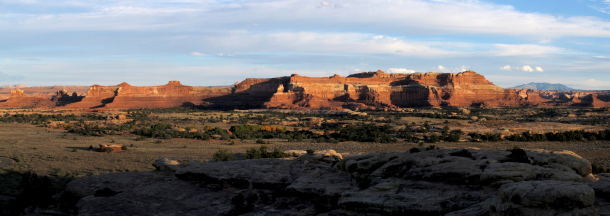
U.S. Secretary of the Interior Deb Haaland initiated a task force to recommend new names for public lands labeled with disrespectful terms such as Squaw Canyon and Squaw Flats in Canyonlands National Park. (Photo: Thomas Jundt, Flickr, CC BY-NC 2.0)
O’NEILL: Wow 660, just for that particular slur. It feels like the bare minimum we could be doing is removing such terrible language from the land that we've already taken from these people.
DYKSTRA: That's right. There's one that has already changed. It was a Union Army General in the late 19th century, William S. Harney, he was a cavalry officer who led Indian massacres. His name was on a sacred mountain in South Dakota believe it or not, the name was changed from honoring Harney to honoring Black Elk, a Lakota medicine man. There's one not in public lands but the town of Sheridan, Wyoming, about 60 or 80 miles south of Little Bighorn is named after a notorious Union Army General who coined the phrase, 'the only good Indian is a dead Indian'. There's no movement to change that town name. But another example of a name that's more than a little bit offensive to some.
O'NEILL: Well, with any luck, Secretary Haaland's task force will get some more respectful terminology for these public lands.
DYKSTRA: Right.
O'NEILL: And what do you have for us from the history books this week, Peter?
DYKSTRA: May 29, 1905 there was an irrigation project, turned out to be very poorly designed, failed in Southern California and a depression in the land in the desert east of San Diego became the Salton Sea. As irrigation water flooded this low land in the desert. It's a major stop for migratory birds but today the Salton Sea is battling major pollution problems. Ironically, within a couple of decades of the Salton Sea being created, Owens Lake to the north, was pretty much drained and turned into desert and dust as the result of growing water needs of Los Angeles.
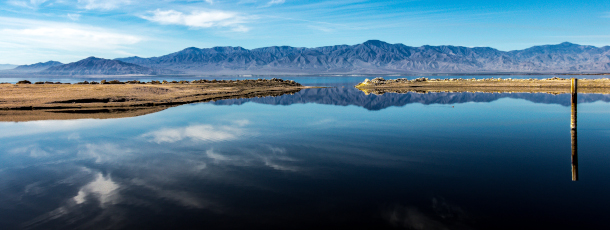
The Salton Sea was created in 1905 when an irrigation engineering project along the Colorado River got out of hand. Many species have adapted to the Salton Sea including migratory birds. (Photo: Kevin Dooley, Flickr, CC BY 2.0)
O'NEILL: Well it looks like we're losing a lake to pollution when we once lost one to overconsumption.
DYKSTRA: Yeah, and of course the water problems for all of the southwestern cities, Las Vegas, San Diego, Phoenix, LA are really coming to a head.
O'NEILL: Well, thanks, Peter. Peter Dykstra is an editor with Environmental Health News. That's ehn.org and dailyclimate.org. And we'll talk to you again real soon.
DYKSTRA: Okay, Aynsley thanks a lot. We'll talk to you soon.
O'NEILL: And there's more on these stories on the Living on Earth webpage that's LOE dot ORG.
Related links:
- Scientific American | “Offensive Names Should Be Removed from Public Lands”
- BBC | “Australia Election: Anthony Albanese Vows Unity After Labor Seizes Power”
- Learn more about the history of the Salton Sea
[MUSIC: Carlos Nunez, “Para vigo me voy” on Brotherhood of Stars, on Brotherhood of Stars, BMG]
“Trust”: Great Blue Heron
A Great Blue Heron flies toward its mate sitting in the nest with their just-hatched young. (Photo: Mark Seth Lender)
BASCOMB: In many species of birds both parents share the duty of caring for eggs and raising chicks. Living on Earth’s Explorer in Residence, Mark Seth Lender, shares his observations of Great Blue Herons on the Connecticut River.
Trust
Great Blue Heron
Heron rookery inland of the Connecticut River
© 2021 Mark Seth Lender
All Rights Reserved
Cloud lowering from the sky. Blue as starlight at the first glow of morning. Wings wide as a double-doorway. Great Blue Heron! Lands, on the branch above the nest. It bends and springs beneath him. Folds, and steps and comes to rest on the rim, above his mate deep in the nest where she lies, cover, to their just-hatched young.
She does not move.
He looks on.
On her not a feather stirs as if asleep.
His long neck inclines, in her direction. Waits… And waits… And looks and waits… And the great wide foot of him reaches out and touches her back – tap-tap – gently as that.
And nothing...
(tap-tap-tap)
And nothing...
(tap-tap)
At last!
She raises her head but will not turn, does not look at him. He makes no further move. Him in certainty and patience. Her, like a bell before it chimes. Both in review of their silent conversation:
“It’s all right,” (tap-tap). Trust me with them,” (tap).
The female Great Blue Heron leaves the nest in search of food after her mate returns. (Photo: Mark Seth Lender)
Says you!
“You are hungry.”
True.
“I will still stay.”
(tap-tap-tap)
You will?
“You can go. Go eat. Everything will be… all right.” (tap-tap-tap) “Go.”
Stiff from her long sojourn close and closed as an eggshell, she comes to her feet, a momentary glance at him, then out and over the tall trees, the low hill, towards where river and salt water meet and the tidal flats replete with the fat of the sea.
BASCOMB: That’s Living on Earth’s Explorer in Residence Mark Seth Lender. For photos check out the Living on Earth website, loe.org.
Related links:
- Find the field note for this essay here
- Mark Seth Lender’s website
- Thanks to Destination Wildlife
- Learn more about the Great Blue Heron
[MUSIC: Carlos Nunez, “Two Shores” on Brotherhood of Stars, traditional northern Galician]
Justice for Oil Spill Victims in Nigeria

Chima Williams brought Royal Dutch Shell to justice for negligence in preventing oil spills in two communities (Photo: Goldman Environmental Prize)
O’NEILL: So Bobby, on this show we hear a lot about the many ways humans are damaging the environment.
BASCOMB: Oh man, that’s the truth.
O’NEILL: But the annual Goldman Environmental Prize celebrates the people working to protect our planet, and we have a series of interviews coming up with this year’s winners.
BASCOMB: Right, the Goldman prize is sometimes called the Green Nobel and it’s awarded to one winner from each continent. I hear you recently spoke with the winner from Africa.
O’NEILL: Yes! Chima Williams is a lawyer from Nigeria. He secured an unprecedented legal win at the Hague in the Netherlands against Royal Dutch Shell for its negligence in preventing oil spills in the Niger Delta.
BASCOMB: Yeah, I know that oil spills happen all too often in Nigeria, but rarely do we hear about companies actually being brought to justice for them.
O’NEILL. Exactly. And going up against Shell, one of the biggest oil companies in the world, wasn’t exactly easy. Chima says that some people told him it couldn’t be done.
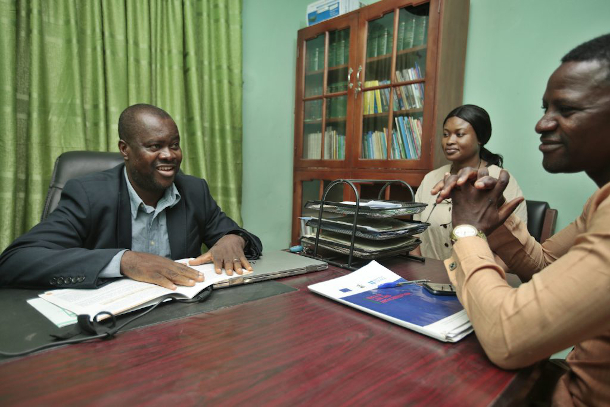
Chima Williams and colleagues at Friends of the Earth Nigeria, where he is Executive Director (Photo: Goldman Environmental Prize)
WILLIAMS: How can you challenge the almighty Shell, you know, how dare you challenge them, for the conduct and the practice that they have been engaged for years? But for us, because we have the conviction, because we have the belief, that look, until you think out of the box, you may not create the needed positive change.
BASCOMB: So how did they manage to bring Shell to justice?
O’NEILL: Well Chima and his legal team started by poring over dozens of examples of Shell oil spills in the Niger Delta, looking for the ones that seemed most clearly linked to negligence. And they landed on two in particular that seemed like open-and-shut cases, in the communities of Goi and Oruma. In 2004, Shell’s Trans-Niger pipeline developed a leak near Goi, but it didn’t stop there.
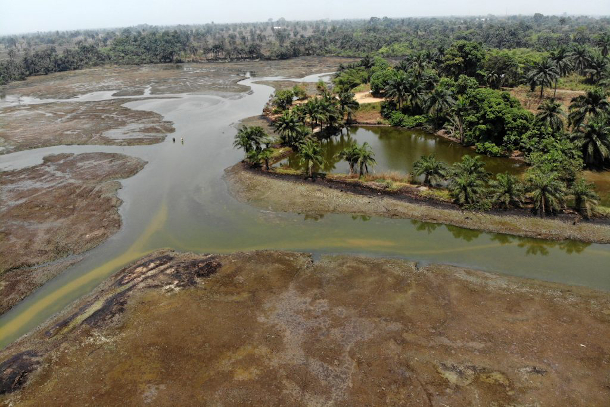
Oil pollution from the spill in Goi, Nigeria (Photo: George Osodi)
WILLIAMS: There was an explosion, fire explosion, that further helped to destroy things that were left by the spill pollution.
O’NEILL: And Chima says that even though the explosion from the spill was big news, Shell didn’t bother to clean it up until 33 months later.
BASCOMB: Wow, it took them nearly three years to clean it up?
O’NEILL: Right, and in 2005 another Shell pipeline near Oruma leaked for 12 days, polluting the land and drinking water.
BASCOMB: Wow, that’s awful. How did these spills affect the people living in Goi and Oruma?
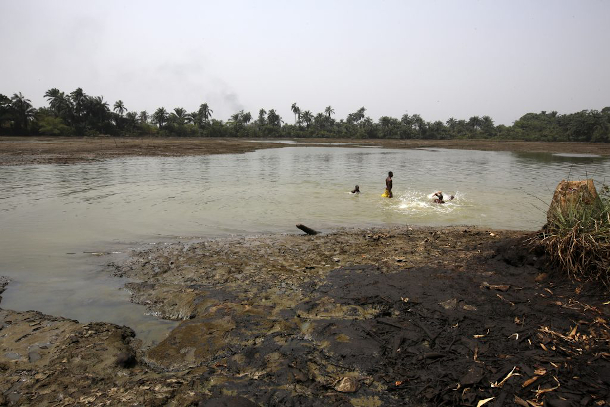
The Goi oil spill and explosion polluted farmers’ land, drinking water, and fishing ponds (Photo: George Osodi)
O’NEILL: It was pretty devastating, here’s Chima again.
WILLIAMS: People could no longer use their farmlands. People could no longer harvest fishes from their fish ponds. People could no longer harvest from their economic trees, which provided a source of livelihood for them. It was a huge and massive loss, and it affected majority of the community of people because there are indirect impacts and effects on people who unsuspectingly will drink, for example, from the polluted water, will use it to cook their food, will use it to bathe.
O’NEILL: The spills also released air pollutants that these communities were unknowingly breathing in.
WILLIAMS: So, people now would die mysteriously, or have strange ailments that is unexplainable. And we find in some situation it is either people begin to accuse each other of poisoning, or they will attribute it to activities of witches and wizards. Because what they cannot explain, they have to give it a name.
O’NEILL: Fortunately, Chima and his colleagues at Friends of the Earth Nigeria, where he’s the executive director, were able to help set the story straight for the villagers, that it wasn’t their neighbors who were poisoning them or using dark magic. It was a powerful corporation that did this to them. More specifically, it was Shell’s failure to install leak detection systems. They are standard practice in oil pipelines in Western nations, but Shell just didn’t bother with them in Nigeria. And during their investigation Chima and his legal team gained access to internal Shell documents that revealed the company knew the Goi pipeline was poorly maintained and needed replacement, and that executives had lied about it in court.
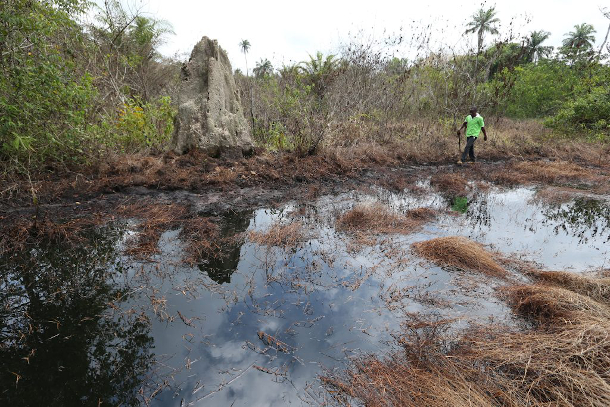
Oil pollution in the Niger Delta (Photo: George Osodi)
BASCOMB: Wow. So, I think you said that they won this legal victory in the Hague. But why did they have to go all the way from Nigeria to the Netherlands to get justice?
O’NEILL: Well, they wanted to try something different since the status quo just wasn’t working. Chima and his colleagues had won a previous case against Shell in 2005 over the company’s practice of gas flaring, another way oil extraction has polluted the air that people in the Niger Delta breathe. The federal high court of Nigeria ordered Shell to stop the flaring, but three years after the ruling, the company had still not complied.
WILLIAMS: The idea was, well, since the multinationals don’t respect the judgements of Nigerian courts, and the Nigerian authorities that are supposed to enforce this judgment are not enforcing it, let’s take them to their own home countries, where we believe that they will respect the law, they will obey and comply with court judgments.
O’NEILL: But Bobby, they actually lost the oil spill case, at first. The District Court of the Hague ruled in 2013 that Shell couldn’t be held liable for the actions of its Nigerian subsidiary. But that didn’t stop Chima.
WILLIAMS: Of course, that is the beauty of the right to appeal, if you feel strong about your case, like we did. When we lost at the lower court in the Hague, we were convinced that we were not supposed to lose the case, especially on the grounds that the court based to deliver the judgment against us.
O’NEILL: So they appealed and finally, in January 2021, the Court of Appeal of the Hague ruled that Royal Dutch Shell ultimately has oversight and control over the operations of its Nigerian subsidiary, including a duty to prevent oil spills. As a first step, the court ordered Shell to install a leak detection system on the Oruma pipeline, so this hopefully doesn’t keep happening.
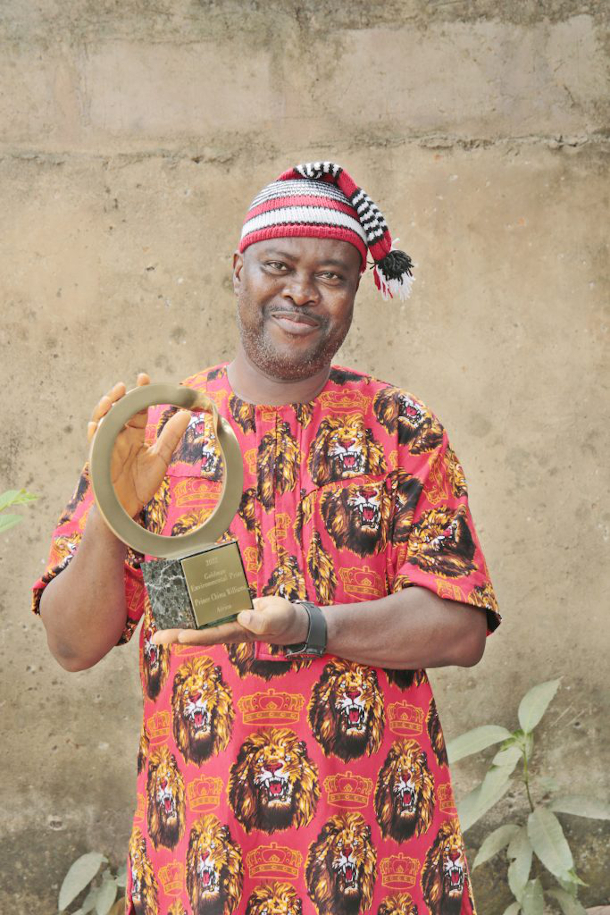
Chima Williams with the Goldman Environmental Prize (Photo: Goldman Environmental Prize)
BASCOMB: Well, that’s something I guess. But what about the farmers whose land was polluted?
O’NEILL: The court ruled that Shell must compensate them, but the amount is pending, so these farmers are still waiting for justice nearly 20 years after these spills occurred. But Chima says it’s not just about the money.
WILLIAMS: When you have wronged somebody, change of attitude brings a lot of succor. Seeing that there is restitution coming from the inside will mean that if you have the opportunity you will not repeat those things that happened. And I think that is the greatest debt that the oil companies owe the people of Niger Delta. To show that empathy to the people for the long years of destruction of their source of livelihood, their environment and creation of problems for them. There can be no better way of any compensatory offer than that. That is what I expect to come from them.
BASCOMB: I would sure hope so. Well, thanks Aynsley for bringing us Chima Williams’ story, and I’m really looking forward to hearing from the other Goldman Prize winners in the coming weeks.
O’NEILL: Yeah! The prize is given to a winner from each inhabited continent, so among others we’ll hear from the recipients from South and Central America, two young Indigenous leaders who got Ecuador to cancel dozens of illegal gold mining concessions in their territory.
BASCOMB: And I spoke with the winner from Asia, a Thai activist who led a campaign against a blasting project that would have destroyed nearly 250 miles of the Mekong River.
O’NEILL: Wow, I can’t wait to hear that.
Related links:
- Watch: Chima Williams’s Acceptance Speech for the 2022 Goldman Environmental Prize
- Watch: Chima Williams’s story
- Goldman Environmental Prize: Meet the Winners
[MUSIC: Carlos Nunez, “Two Shores” on Brotherhood of Stars, traditional northern Galician]
Albatross Divorce Amid Warming Waters
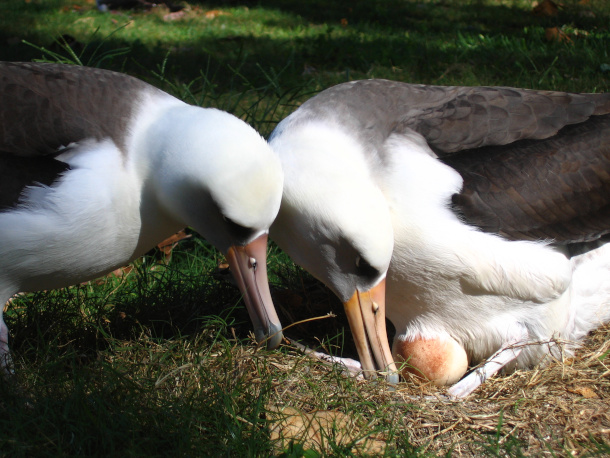
Albatross parents tend to their egg. (Photo: David Patte, US Fish and Wildlife Service, Flickr, CC BY-ND 2.0)
BASCOMB: Coming up after the break NASA has the first ever recordings from Mars but first this Note on Emerging Science from Don Lyman.
[SCIENCE NOTE THEME]
LYMAN: Albatrosses, like most bird species, are monogamous, usually mating for life. However, a new study has found that warming ocean waters induced by climate change has led to an increase in albatross leaving their mates prematurely. The typical divorce rate for albatrosses is less than four percent, but researchers in the Falkland Islands found that rate doubled to nearly eight percent in years when the ocean was warmer than usual.
The scientists analyzed data collected from 2004 to 2019 on a large colony of black-browed albatrosses living on New Island in the Falklands. Breeding failure was still the main factor behind the albatrosses separating, but the divorce rate increased with a commensurate increase in average water temperatures and reached a maximum of 7.7% in 2017 when the ocean waters were the warmest. The researchers found that the probability of divorce correlated with rising water temperatures, and even females in successful breeding pairs were more likely to be affected by the warmer water than males or females that either didn’t breed, or failed in their attempts to breed.
When ocean temperatures decreased in 2018 and 2019, albatross divorce rates decreased as well. The researchers said this is the first evidence that environmental factors, and not just breeding failure, can cause wild birds to split up. Scientists said that warmer water has fewer nutrients, so they speculate that some birds may be out at sea longer than usual searching for food, which delays their return to the colony and if members of a pair return at different times, it could cause them to break up. Or, if they don’t get enough food, they could return looking unhealthy and unfit for breeding.
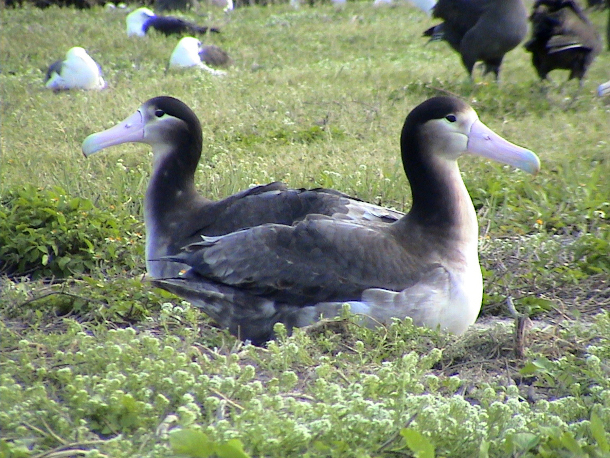
A short-tailed albatross pair faces away from each other. (Photo: FWS Klavitter, US Fish and Wildlife Service, Flickr, CC BY-ND 2.0)
Plus, researchers hypothesized that worse environmental conditions might increase stress-related hormones in the birds, which could affect mate choice. The scientists speculate that a bird could incorrectly attribute its stress to its mate, instead of to the harsher environment, and leave its mate even if hatching was successful.
Researchers say black-browed albatross populations are healthy, with a high availability of alternative mates, so an increase in divorce rates does not raise immediate conservation concerns. But populations of other species of albatrosses are in decline, so if this environmentally-driven divorce is documented in those species it could be cause for concern. That’s this week’s note on emerging science. I’m Don Lyman.
[SCIENCE NOTE THEME]
Related link:
The Conversation | “Climate Change Is Making Monogamous Albatrosses Divorce – New Research”
ANNOUNCER: Funding for Living on Earth comes from you, our listeners, and United Technologies, combining passion for science with engineering to create solutions designed for sustainability in aerospace, building industries and food refrigeration.
[CUTAWAY MUSIC: Michael Hedges, “Woman of the World” on Live on the Double Planet, by Michael Hedges, Windham Hill]
The Sounds of Mars

A panoramic view of Perseverance’s landing site on February 18, 2021. (Photo: NASA, Public Domain)
BASCOMB: It’s Living on Earth, I’m Bobby Bascomb.
O’NEILL: And I’m Aynsley O’Neill.
O’NEILL: So, Bobby most of our stories here feature sounds from Earth but I’ve been listening to some really out of this world recordings lately.
BASCOMB: Oh, really? What do you mean, Aynsley?
O’NEILL: Well, NASA spacecraft first landed on Mars with the Viking 1 in 1975. And finally, now after almost 50 years and dozens of missions, the Perseverance rover has recorded the first sounds ever captured on the surface of the red planet.
BASCOMB: Oh, wow, so what does Mars sound like?
O’NEILL: Well, I wasn’t sure what I should be expecting at first – my original impression of what Mars could sound like was based on Ridley Scott’s movie adaptation of The Martian.
[SFX: “THE MARTIAN” AUDIO]
[SFX: STORM]
LEWIS: Visibility is almost zero. Anyone gets lost, home in on my suit's telemetry. You ready?
WATNEY: Ready!
[SFX: STORM]
WATNEY: Commander? Are you okay?
LEWIS: I’m okay!
[SFX: STORM]
CURWOOD: So I’m gonna guess that’s not quite what NASA’s audio sounds like.
O’NEILL: No, not exactly. For one, there’s no sweeping movie score to accompany it. Actually, in the first raw audio captured from Mars, most of what you can hear is just the humming of the Perseverance rover. That’s where the microphone is mounted.
[SFX: FIRST SOUNDS FROM MARS – RAW AUDIO]
O’NEILL: But with a little audio filtering, NASA dialed back those rover sounds, and the wind from the planet comes through a little stronger.
[SFX: WIND ON MARS]
O’NEILL: There’s also the sound of the Perseverance rover rolling across the Jezero Crater just a few Martian weeks into its mission.
[SFX: ROVER DRIVING ON MARS – FILTERED]
O’NEILL: And for the first time, a spacecraft on another planet recorded the sounds of a separate spacecraft when Perseverance used one of its microphones to listen to the Ingenuity helicopter during its fourth flight on Mars.
[SFX: HELICOPTER FLYING ON MARS]
BASCOMB: Now, Mars has a different atmosphere than Earth, so that’s sure to alter how sound waves move, right?
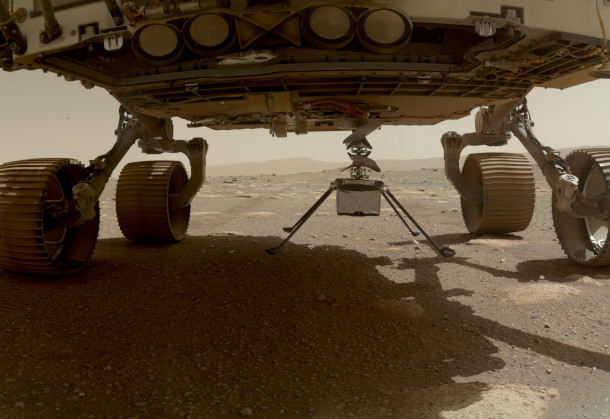
In this photo, the Ingenuity helicopter is deployed from underneath the Perseverance rover. (Photo: NASA, public domain)
O’NEILL: Yeah, the atmosphere of Mars is roughly 96% carbon-dioxide, and those molecules absorb a lot of higher pitched sounds, so only low pitch sounds would be able to travel long distances on the red planet. So, the sounds of some city birds here on Earth
[SFX: EARTH BIRDS]
get lost on Mars.
[SFX: MARS BIRDS]
O’NEILL: Also, because the atmosphere is around 100 times less dense than Earth, there are fewer atoms for the sound waves to vibrate through, so volume would be quite a bit softer than here on Earth. The sharp sound of a bike bell
[SFX: EARTH BIKE BELL]
gets muffled on the red planet.
[SFX: MARS BIKE BELL]
O’NEILL: To top it off, Mars’ average surface temperature hovers around negative 80 degrees Fahrenheit.
BASCOMB: Wow, that’s cold – what does that do to the sound?
O’NEILL: All these factors work together to make the Martian speed of sound a little slower than on Earth, where it moves at around 340 meters per second. And on Mars there are actually TWO speeds of sound: low-pitched noises travel at around 240 meters per second, while higher-pitched noises clock in at 250 meters per second. This is because the carbon dioxide molecules in the atmosphere vibrate too rapidly at higher frequencies, and don’t have the time to slow down.
BASCOMB: So, any person on Mars would have to be in a space suit to breathe, of course, but let’s just imagine that two people were able to talk to each other – what would that sound like?
O’NEILL: Well, that would depend on the distance between the two people, but overall, sound would be quieter, and it would take those people a little bit longer to hear each other.
BASCOMB: So, on an alien planet, we would even sound a little alien.

The Perseverance rover is now moving up the slope of the Jezero crater, looking for new rock samples. (Photo: NASA, public domain)
O’NEILL: Yep, and NASA even has a tool that will allow you to filter your own Earth audio, so you can hear what it would sound like on Mars.
For example, let’s wrap up by listening to a familiar song. Maybe the Living on Earth theme tune?
BASCOMB: Sure, go for it!
[SFX: LOE THEME, MARS VERSION]
O’NEILL: The Perseverance Rover is now beginning a new stage of its mission, rolling up the slope of the Jezero crater to collect a group of rock samples that scientists are hoping might contain hints of ancient life on the planet’s surface.
Related link:
Find out more about the audio captured on Mars at NASA’s website
[MUSIC: Michael Hedges, “Woman of the World” on Live on the Double Planet, by Michael Hedges, Windham Hill]
Safeguarding the Cedars of Lebanon
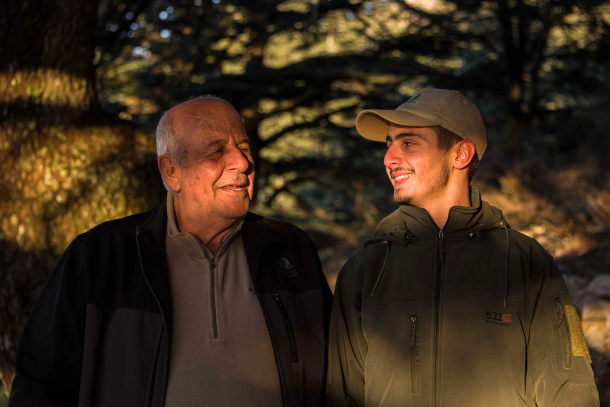
Talal Riman, pictured here with new forest guide, Farid Tarabay, 19, finally retired from his work with the cedars after almost 30 years, in September 2021, when he turned 64. (Photo: Elizabeth Fitt for Mongabay)
BASCOMB:Lebanon is grappling with its worst economic crisis in decades. In the last two years the Lebanese pound has lost roughly 90% of its value, businesses are closing, and unemployment is nearly 30%. But despite the desperate times, communities near the Al-Shouf Cedar Nature Reserve are doubling down on land restoration and reforestation, sustainable agriculture and eco-tourism.
Al-Shouf is a UNESCO Biosphere Reserve, home to the country’s iconic cedar forest. The reserve is a multicultural inclusive endeavor. The majority of the population is Druze, an ethno-religious group that settled the land the middle ages. It’s also home, to Greek Orthodox Christians, Maronites, Sunni Muslim and Syrian refugees. Elizabeth Fitt is a freelance photojournalist based in Beirut. She wrote a story about the Shouf Biosphere Reserve and the community that protects it for Mongabay. Elizabeth Fitt, welcome to Living on Earth!
FITT: Hello, Bobby, thank you so much for having me.
BASCOMB: So please describe the Shouf Biosphere Reserve for someone who hasn't been there. What does it look like? And what does it feel like when you're there?
FITT: The Shouf Biosphere Reserve sounds like it's a nature reserve. But actually, it's not a nature reserve. It's more of a living laboratory for testing ways to store the landscape sustainably for the health of the environment, but also for the well-being of the 228,000 people who live within the reserve area. It's about 10 times the size of Manhattan, give or take. And it's beautiful. It's very rural. It's about 2000 meter high mountain peaks, which sort of go marching off into the distance above the lower slopes, which are covered in a patchwork of agricultural land, mostly terraces, and little villages with gorgeous old stone buildings. And just being out in the, I guess in the, in the countryside, the air feels really fresh and clean, especially in the cedar forests where it noticeably feels delicious for your lungs to breathe that air. And it's really, it's very calm and it's very quiet, but it's also very full of life.

Nizar Hani, director of the Shouf Biosphere Reserve. (Photo: Elizabeth Fitt for Mongabay)
BASCOMB: Tell me please about the biodiversity of the region. You know, the unique plants and animals that live there.
FITT: Well, there are certainly a lot of plants and animals. There are 32 different mammal species, more than 275 bird species, I think something around 31 amphibian and reptile species and that includes wolves, striped hyenas, jackals, porcupines, chameleons, tortoises, badgers, eagles, snakes, storks, and I know that there's lots more that I can't remember. Oh, hyraxes, which are otherwise known as rock rabbits. There's an absolute wealth of different creatures. If you go for a walk or a drive, you can see wild flowers and herbs which are just growing by the side of the roads and across the slopes. And I don't think we had a single twilight drive back to our accommodation without seeing at least one fox or jackal. You know, butterflies and bees everywhere, I mean, it was really apparent. Actually, the director of the biosphere reserve, Nizar Hani, he was telling me that at the beginning of the project, the only wolves there were lone wolves. But nowadays, the wolves actually are operating once more in established family groups due to the biosphere’s work. Their projects have wilded some of the landscape to the point where the wolves have a safe habitat.
BASCOMB: Now Lebanon endured a really grueling Civil War from 1975 to 1990. And to some degree, that's when the Shouf Biosphere Reserve was established by a local leader named Walid Jumblatt. Can you tell us please about what he did and, and how he went about protecting the forest?
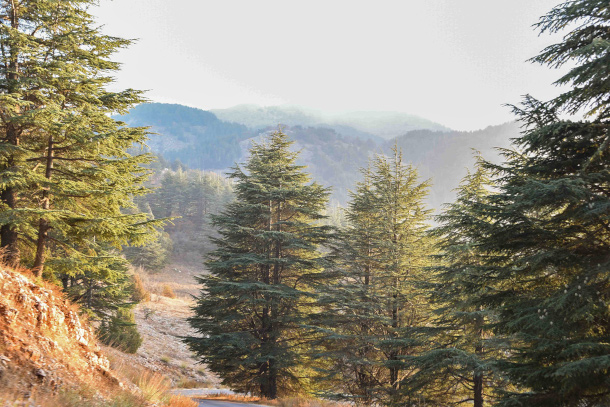
Cedars in the Barouk area of the SBR. (Photo: Elizabeth Fitt for Mongabay)
FITT: Yes. Indeed, the ecology of some parts of the area has been protected for a lot longer than the reserve has existed in its current form. Now, what you're referring to there is the cedar forest areas, which is an area of just over I think 600 hectares within the reserve, in which grow the iconic cedars of Lebanon. Those trees are revered by Lebanese culture as just being hugely, hugely important through everything from music to art to the flag of the country. So during that Civil War, Walid Jumblatt, he's a, he's a politician, and he's a local Druze leader and he did indeed take some quite extreme steps to conserve the cedar forests. He said to people, you know, stay out of the forest because people were sort of going in there willy nilly logging, smoking is a very popular habit, dropping cigarettes, starting fires. So, he tried telling people to stay out but he said that not all of them listened. So he resorted to installing landmines to protect the forest, installed land mines and then he blocked access routes to the cedar trees with earth berms and had all entrances barred using armed men and that continued for years all the way up until about 1996, I think. So I mean, a vastly different way to conserve nature there, I mean, really very different. And these days, instead of keeping people out with force, the reserve invites them in. It welcomes them as stakeholders in the natural resources of their area. Educates them on how best to manage the landscape, to the benefit of all.
BASCOMB: Can you tell us more about that? As you mentioned, I understand that they traded land mines and armed guards for tourism and sustainable harvesting. How exactly are they going about, you know, approaching conservation there today?
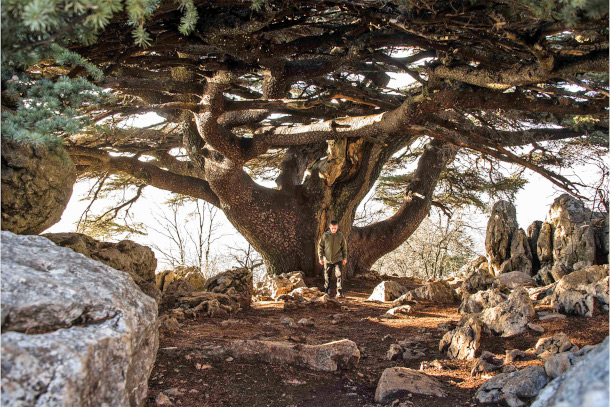
Farid Tarabay, the new forest guide, under the Lamartine Cedar, one of the oldest in the SBR. (Photo: Elizabeth Fitt for Mongabay)
FITT: So these days, the reserve seeks to involve the local community in what it does, I mean, they are a key part of that landscape. What they have done is sets up cash for training courses, where they pay people to attend training, and cash for jobs, cash for work programs. So, there you can see an immediate positive for people in the area, especially in in a country that's suffering an economic crisis, such as Lebanon as jobs are scarce. And the reserve is helping provide people with some of those jobs. But everything that this reserve does is fascinating. They seem to have managed to join the dots where each thing that they do fits into a sort of network that impacts all sorts of other things. And I'll give you an example of that. They have a fire issue in summer in there since it's dry in the summer, it's very hot and every year parts of the forest burn. And one of the things that they do is clear out biomass from the forest floor, which basically leaves any fire that does start with far less fuel, to fuel it into something that becomes uncontrollable. The biomass that they remove, just you know, branches, old wood, undergrowth, these kind of things, they shred all of that and then they mix it with pomace. And it's a byproduct of olive oil production. And turn them into what they call eco briquettes, which is like these little, little brown logs made of flammable material, which people can use to put in their stoves and to cook with. So, you've then got an actual product coming out of this environmentally friendly, job creating project, you've even then got something that is a business coming out of it as well, too. And this is particularly important in this region at this time for people to have affordable fuel, because they can't afford to heat their homes anymore, because the fuel that usually they would heat them using stoves, which have usually diesel or gasoline, those kinds of fuel prices have gone up, I think, around about 1,800% in 2001. And then since the war in Ukraine started, they've gone up a further 70%. We are out of the winter now, so people are less cold. But during the winter months, people are desperate for fuel to burn to keep their family warm and to cook with. So it's really, really important. I mean, temperatures there can get down to negative 10. I mean, it can get very, very cold, it's quite high altitude. So having this much more affordable, eco-friendly option for fuel, it's fantastic. And this year, actually there is a distributed to the most needy people. Distributed the eco-briquettes for free. And it still doesn't end there. So, the olive pomace would have been dumped into the river systems where apparently it's very acidic, and it harms the aquatic life and destroys the ecology there. So that's another knock-on effect, that's no longer happening.
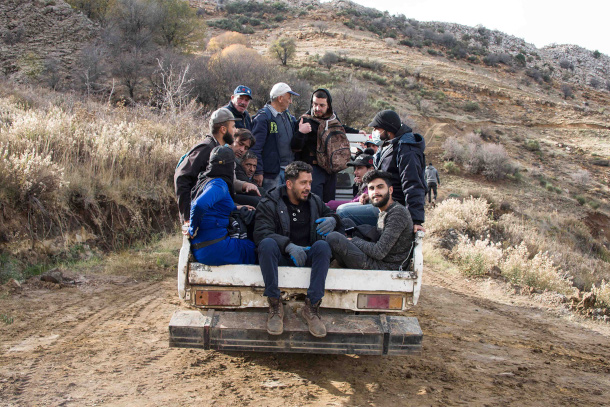
Workers heading home in the back of a truck after a day planting indigenous seedlings on an SBR reforestation project near Niha, Shouf. (Photo: Elizabeth Fitt for Mongabay)
BASCOMB: Now I've read that temperatures are rising really quickly in the area as a result of climate change. And you mentioned earlier forest fires being such a problem. How is climate change in general impacting the Shouf Biosphere Reserve?
FITT: That is absolutely true, they are rising fast. The predictions that I've seen, they are that temperatures will increase here between 1.2 and 1.7 degrees Celsius by 2050. So that's, that's a huge and quite concerning increase. So, what the reserve does is try to build the capacity of the landscape it manages to be more resilient to these changes in a number of ways, actually. But there's a lot of work going into making sure that the trees planted as part of several reforestation initiatives in the area are as genetically resilient as possible. I spoke with a man called Khaled Sleem. He's an agricultural engineer who runs a local indigenous tree nursery within the reserve and advises the reserve, as well as providing them with seedlings to plant. He has been doing that for about 17 years and he's born and bred in the reserve area. And he was telling me that all of the seedlings that the reserve uses in its reforestation projects are grown from seeds collected in the area, rather than from seeds from elsewhere, and rather than from cloned cuttings. Now he said, that's an effort to ensure maximum genetic diversity and that is what he hopes will result in trees with a greater chance of surviving longer as climate change bites. And he's developed also a special root air pruning pot, which he plants the seeds in there, and the seedlings begin in these in these funny looking little black pots with grooves down the sides. Which as the roots grow it trains the roots in a certain direction and then exposes them to the air. So the roots are carefully trained before the seedlings are planted out into the wild to have really strong root networks by this air pruning. And I mean, this is really working very well for them so far, because the seedling survival rates since they have turned to root air pruning has increased from 15% survival only to over 90%. So that's hope that the resilience of those root systems will help these little trees grow through a period of warming, more resiliently than they otherwise would.
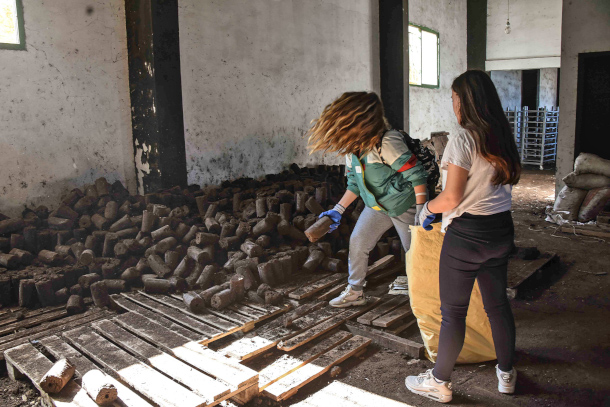
Young adults pack eco-briquettes while learning about sustainable restoration techniques on a Lebanese Reforestation Initiative SBR program. (Photo: Elizabeth Fitt for Mongabay)
BASCOMB: Well, that's amazing. They've really thought this through.
FITT: Yeah, and one other thing that really struck me, I think the second reason there may have been less plundering of local natural resources in these very tough times, and I really felt the impact of this during my visits, everyone and I mean, everyone I met, from shopkeepers, to hikers, to shepherds, to university students, really people totally unaffiliated with the reserve, just that I met on the street, they knew about the reserve, they were able to discuss how it's helping the region, and were unanimously enthusiastic about it. And it was actually really inspiring to see that level of local buy in. And I would say a good indicator that the methods being tested here they're working. I don't think you'd see that level of positivity if there weren't some proof to the pudding.
BASCOMB: Elizabeth Fitt is a freelance journalist and photographer currently based in Beirut, she wrote about the Shouf Biosphere Reserve for Mongabay. Elizabeth, thank you so much for your time.
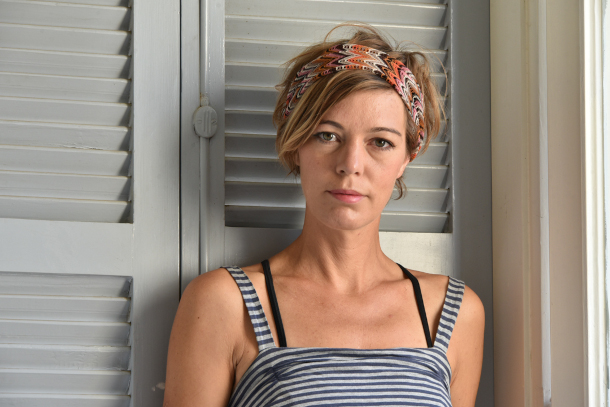
Elizabeth Fitt is a freelance journalist and photographer currently based out of Beirut, Lebanon. (Photo: Courtesy of Elizabeth Fitt)
FITT: You're very, very welcome. Thank you for having me.
Related links:
- Learn more about the Shouf Biosphere Reserve
- Read Elizabeth Fitt’s Piece for Mongabay From Land Mines to Lifelines, Lebanon’s Shouf is a Rare Restoration Story
- Follow Elizabeth Fitt via Instagram @elizabethfittphotography
- Elizabeth Fitt’s work for Middle East Eye
[MUSIC: Biff Smith, “It Might As Well Be Spring” on Biff Smith Solo Piano, by Richard Rodgers, published by Biff Smith]
O’NEILL: Living on Earth is produced by the World Media Foundation. Our crew includes Naomi Arenberg, Paloma Beltran, Chloe Chen, Iris Chen, Josh Croom, Delaney Dryfoos, Jenni Doering, Mark Kausch, Mark Seth Lender, Don Lyman, Louis Mallison, Sophia Pandelidis, Jake Rego, Teresa Shi, and Jolanda Omari.
BASCOMB: Tom Tiger engineered our show. Alison Lirish Dean composed our themes. We say goodbye this week to our intern Gabriella Diplan, thanks for your hard work, Gabriella! Special thanks this week to Destination Wildlife. You can hear us anytime at loe.org, Apple Podcasts and Google Podcasts, and like us, please, on our Facebook page - Living on Earth. We tweet from @livingonearth. And find us on Instagram @livingonearthradio. Steve Curwood is our Executive Producer. I’m Bobby Bascomb.
O’NEILL: And I’m Aynsley O’Neill. Thanks for listening!
ANNOUNCER: Funding for Living on Earth comes from you, our listeners, and from the University of Massachusetts, Boston, in association with its School for the Environment, developing the next generation of environmental leaders. And from the Grantham Foundation for the protection of the environment, supporting strategic communications and collaboration in solving the world’s most pressing environmental problems.
ANNOUNCER 2: PRX.
Living on Earth wants to hear from you!
Living on Earth
62 Calef Highway, Suite 212
Lee, NH 03861
Telephone: 617-287-4121
E-mail: comments@loe.org
Newsletter [Click here]
Donate to Living on Earth!
Living on Earth is an independent media program and relies entirely on contributions from listeners and institutions supporting public service. Please donate now to preserve an independent environmental voice.
NewsletterLiving on Earth offers a weekly delivery of the show's rundown to your mailbox. Sign up for our newsletter today!
 Sailors For The Sea: Be the change you want to sea.
Sailors For The Sea: Be the change you want to sea.
 The Grantham Foundation for the Protection of the Environment: Committed to protecting and improving the health of the global environment.
The Grantham Foundation for the Protection of the Environment: Committed to protecting and improving the health of the global environment.
 Contribute to Living on Earth and receive, as our gift to you, an archival print of one of Mark Seth Lender's extraordinary wildlife photographs. Follow the link to see Mark's current collection of photographs.
Contribute to Living on Earth and receive, as our gift to you, an archival print of one of Mark Seth Lender's extraordinary wildlife photographs. Follow the link to see Mark's current collection of photographs.
 Buy a signed copy of Mark Seth Lender's book Smeagull the Seagull & support Living on Earth
Buy a signed copy of Mark Seth Lender's book Smeagull the Seagull & support Living on Earth

